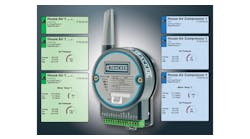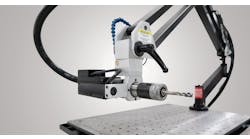Process control is moving forward as quickly as data collection and processing can carry it, and a recent research effort demonstrated how fast and flexible, and adaptive, machining operations can be. A research team at Fraunhofer Institute for Production Technology (IPT) in Aachen, Germany, have experimented with smart sensors that are wirelessly attached to a workpiece, to improve the understanding and control of production processes, so that processes can be flexibly monitored and adaptively controlled.
The intelligent process control system can process large volumes of data and transmit it almost instantly using 5G broadband telecommunications and cloud technology.
Industrial partners working with IPT were Marposs Monitoring Solutions GmbH, Meastream GmbH, and Oculavis GmbH, with associate-level participation by QSQ, CP Tech GmbH, Ericsson GmbH, and MTU Aero Engines AG. The research was funded by the European Regional Development Fund (ERDF.)
Their goal with the "5GSensPRO" project is to gain direct insight into production processes, to identify maintenance needs and failure risks in real time – and also to convert that rich detail into a targeted and adaptive process control system. The solution they have published combines control technology with high-speed mobile communications to connect sensor data with machine controls.
5G for real-time control
A combination sensor / data processing / radio unit called the 5G Edge Computing Device is attached directly to a workpiece and integrated into the manufacturing process. This device can process sensor data before it is transmitted, and connect it to the production machine via 5G.
The data generated by the sensors and machine also can be accessed remotely via augmented reality (AR) technology using a tablet or smartphone, for direct quality monitoring.
According to IPT, the combination of 5G and intelligent sensor technology allows data processing “in the millisecond range,” even for complex movements of the component and machine. The data is already pre-processed in the 5G Edge Computing Device so that only relevant process data is transmitted. In combination with 5G, this opens up possibilities for real-time control of highly dynamic processes, and if the data is stored in the Cloud it can be mapped there as a digital twin and used for long-term analysis.
Adaptive control of milling
IPT and its research partners tested the 5G-based control architecture using the example of CNC milling of a blisk for turbomachinery: The 5G Edge Computing Device was mounted directly next to the component. The device recorded process data directly on the component – including vibration or temperature readings – and processed this data before sending via 5G a distilled version of it to a control unit in the machine cabinet, which monitors and controls the process.
The data was also sent to a local computing unit (the so-called edge Cloud) and stored for further data analysis. This example shows how 5G can be used in combination with the edge Cloud, as a means for better control of the production process.
According to IPT, during the 5GSensPro project it also was possible to test complete and direct connection of a production machine via 5G:
"The 5G-based architecture presented exemplifies how decentralized edge components and central cloud systems complement each other in a modular approach. Thus we succeed in making production even more flexible and smarter, as demanded by industry," according to 5GSensPRO project manager Sarah Schmitt.






